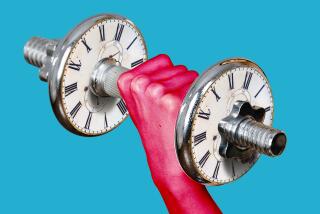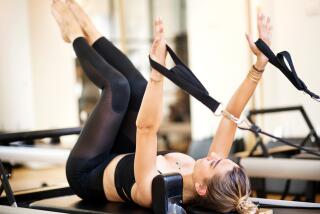In-Your-Face Fitness: Go ahead, run into old age
- Share via
Every time some post-middle-age person tells me he or she had to give up their running habit, I fear a little bit for my future.
I’ve heard many a tale of running woe — people who feel their joints can’t take the discomfort any longer. These reports make me wonder whether I’m destined to wear out my knees, ankles or hips and be forced to give up a sport I love.
I am dubious of these anecdotes because I believe running fixed my body. As a teen I was clumsier than a baby giraffe on a suspension bridge and broke both my ankles, but after a struggling start I found regular running to be therapeutic for these joints.
Running has becoming a life-defining activity for me. And beyond myriad health benefits of intense exercise, it’s a tremendous calorie burner that allows me to drink six-packs of beer yet sustain four-pack abs.
So you can imagine my relief when several experts assured me that I shouldn’t have to give up running ever — as long as I’m careful.
“There is a clear body of evidence that running does not lead to the development of osteoarthritis,” says Reed Ferber, an associate professor of biomechanics at the University of Calgary and director of its Running Injury Clinic. “Some of those studies have good evidence that it is actually protective of joints.”
As far back as 1975, Finnish researchers found that the incidence of osteoarthritis of the hip was lower in 74 former champion runners than it was in regular folks who served as controls. Writing in the British Medical Journal, the researchers also concluded that movement is needed for overall joint health and that immobilization for as little as six days could have erosive effects on joint cartilage.
In 1986, Stanford researchers studied 41 long-distance runners older than 50 and reported in the Journal of the American Medical Assn. that their bone mineral content was 40% higher, on average, than in control subjects. That extra bone mineral helps protect against fractures. Also, the runners had no increased incidence of osteoarthritis.
Another group of Stanford researchers who tracked 45 long-distance runners for 18 years and compared them with 53 controls found no difference in the risk of osteoarthritis in the knees. They reported their findings in the American Journal of Preventive Medicine in 2008.
Add in the fact that running is protective against other health hazards associated with a sedentary lifestyle — like increased risk of cardiac arrest, decreased immune function and accelerated cognitive decline — and you can see why it’s a habit worth keeping.
Ferber says that when the running craze began in the 1970s, some experts assumed that human hearts were designed to beat a certain number of times over a lifetime and that running would use these up more quickly. In reality, regular running can ensure that your ticker ticks a lot longer.
The idea that running wears out the joints is “almost as ridiculous,” he says. “There is zero evidence that this will happen.”
Ferber isn’t the only one who thinks so.
“There is really no evidence that running causes joint injuries,” says Irene Davis, an expert in biomechanics and director of the Spaulding National Running Center at Harvard Medical School.
In fact, Davis says (with apologies to Bruce Springsteen) that humans were born to run.
“I think we evolved to run,” she said. “It’s in our genes and is the most natural exercise we have. It doesn’t make sense that it would wear you out.”
Being heavy may not be an excuse to sit on the sidelines. One 2003 study in the Journal of Biomechanics compared knee loading in 21 obese and 18 lean subjects. When the obese subjects walked at their usual (slower) pace, they experienced less knee loading than the lean subjects. When everyone walked at the same pace, the knee loading was also the same. The authors proposed that obese subjects had an “ability to reorganize neuromuscular function” to protect their knee joints. It’s certainly possible this could be true for a cautiously paced running program as well.
“I’m sure some obese people do have knee pain because they don’t exercise,” Ferber said. “Immobilization has corrosive effects for your cartilage. Moving is what lubricates your joints,” the way motor oil keeps pistons from grinding cylinders under the hood of your car.
That’s not to say it’s impossible to get injured running a marathon or doing a few laps around a track. Davis notes that runners can develop stress fractures or problems with the soft tissue in their legs and feet, such as Achilles tendinitis, plantar fasciitis and IT band syndrome, which occurs when muscles on the outside of the thigh become inflamed.
And joint-related injuries can be aggravated by running. “Once you get osteoarthritis from a previous injury, running can cause some problems,” she said.
Indeed, runners’ enthusiasm for their sport sometimes gets them into trouble, says Lee Herrington, the lead clinician at Knee-Rehab UK in Warrington, England. “If runners avoid injury, they can keep going,” he said. “The problem is runners manage injury badly.”
Yeah, we’re kind of stupid that way — especially those of us over the age of 40. We’re more prone to soft-tissue injuries such as those of the Achilles’ tendons, hamstring and calf muscles. In an article last year in Current Sports Medicine Reports, Dr. Karl Fields of the University of North Carolina at Chapel Hill School of Medicine wrote that older runners need more time to recover from the wear and tear of their workouts — though they often fail to take it.
Although I’m a relatively new member of that over-40 group, I’m still upping mileage to train for my first marathon on March 18 in Los Angeles. But so far I’m pain-free because I’ve learned the importance of pacing through trial and error, with three attempts to take up running in my mid-30s foiled by overexuberant first efforts that left me feeling like I’d been beaten with a bag of Rottweilers.
I’ve also learned that all my weightlifting is beneficial. Muscles in the upper leg absorb 80% of the impact of running, and weight training exercises such as squats can strengthen the Achilles and patellar tendons by spurring growth of collagen fiber, Ferber said. The lesson seems to be that what may feel like a deteriorating joint in aging runners is more likely to be a soft tissue injury that need not spell the end of a running career. It’s just a sign that you don’t recover as quickly as you used to.
I can handle some eventual easing off — so long as I don’t have to stop — because, baby, I was born to run.
Fell is a certified strength and conditioning specialist in Calgary, Canada.






